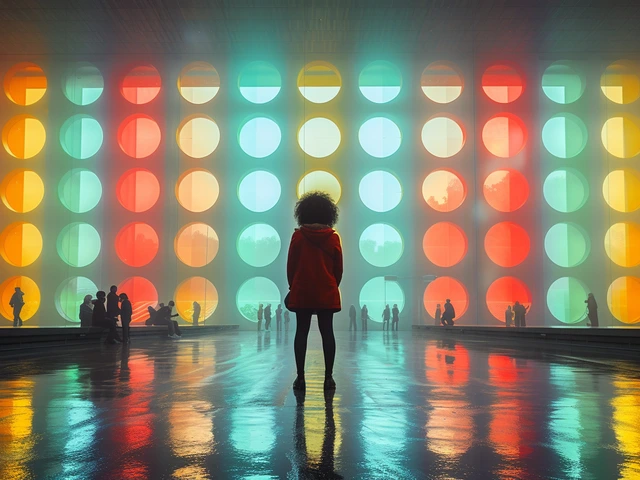A Dive into Constructivism: A Revolutionary Movement
When you hear the term Constructivism, what comes to mind? Planes of metal intersecting in space, perhaps, or abstract compositions that challenge our perceptions of depth and reality. Constructivism was more than just a style or an aesthetic; it was a philosophy, a way of understanding and interacting with the world that fundamentally married the language of art with the precision of science. Originating in Russia in the early 20th century, this movement was born out of a period of immense social and political upheaval. The Russian Revolution set the stage for a rethinking of society at all levels, including how art could contribute to the construction of a new societal order.
Constructivists believed that art should have a practical, societal function - it should 'construct' the world rather than merely reflect it. This belief was revolutionary. Artists and architects like Vladimir Tatlin, Alexander Rodchenko, and El Lissitzky became pioneers, experimenting with materials, forms, and spatial arrangements like never before. Their work wasn't just about creating objects of aesthetic beauty; it was about experimenting with how those objects could serve broader societal and functional purposes. The emphasis on materials - glass, steel, and concrete, in particular - and their properties played a huge role in how Constructivist artists thought about and created their art.
Constructivism's influence didn't stop at the borders of the newly formed Soviet Union. It spread across Europe and even reached the shores of America, impacting the development of other movements such as Bauhaus and De Stijl. What made Constructivism so captivating wasn't just its bold visual language; it was the idea that art could be rational, even scientific, in its approach. This wasn't art for art's sake; this was art as a tool for social and scientific progress.
Constructivism and the Crossroads of Science
At its core, Constructivism sought a synthesis of art and science. The movement's proponents viewed the artist almost as an engineer - someone who uses logic and a deep understanding of materials to solve problems and create new possibilities. This scientific approach to art wasn't just theoretical; Constructivist artists engaged deeply with the scientific discoveries and technological advancements of their time. They took inspiration from physics, mathematics, and architecture, relying on geometry and proportion to create their compositions.
One of the movement's most iconic pieces, Vladimir Tatlin's 'Monument to the Third International,' serves as a testament to this blend of artistic creativity and scientific precision. Envisioned as a towering spiral structure that would have dwarfed the Eiffel Tower, Tatlin's design was never built, but its ambitious concept and engineering marvel continue to inspire artists and architects. Constructivism's legacy in combining the structural and the aesthetic is most visible today in the fields of graphic design, industrial design, and architecture, where functionality and beauty are considered in equal measure.
Understanding the science behind materials and their properties was crucial for Constructivist artists. They experimented with the effects of light on surfaces, the balance and tension between forms, and the dynamic relationship between space and structure. This wasn't just about creating visually arresting pieces; it was about pushing the boundaries of what materials could do and how they could be used to shape human experience in space and time.
Key Figures and Works in the Constructivist Movement
The Constructivist movement was a melting pot of visionary artists and designers, each contributing their unique perspective and innovations. Vladimir Tatlin's work, especially his conceptual 'Monument to the Third International,' symbolizes the ambition and utopian goals of the movement. Alexander Rodchenko's experiments with photography and graphic design exemplified the move towards a more functional, accessible art form. His work in photomontage and his use of unusual perspectives sought to engage the viewer in active, critical seeing, rather than passive observation.
El Lissitzky's 'Prouns' are another cornerstone of Constructivism, blending the boundaries between painting, sculpture, and architecture. Lissitzky saw these works as stations on the way to a new form of spatial expression, where the viewer is encouraged to move around the piece, engaging with it from multiple viewpoints. His influence extended far beyond the visual arts, impacting typography, graphic design, and architectural theory.
While these artists are among the most celebrated faces of Constructivism, they were part of a broader collective of creators who shared a commitment to experimentation, innovation, and the belief that art could indeed construct a new world. This collective ambition laid the groundwork for what would become key principles in modern art and design practices.
Inspiring Modern Creativity: The Legacy of Constructivism
Even though the Constructivist movement is firmly rooted in the early 20th century, its principles continue to resonate in contemporary art and design. The movement's emphasis on functionality, materiality, and the integration of art and science serves as a powerful foundation for modern creators seeking to blend aesthetic appeal with practical application. In today's world, where the boundaries between disciplines are increasingly blurred, Constructivism's interdisciplinary approach is more relevant than ever.
For artists and designers today, revisiting the work and ideas of Constructivist pioneers offers valuable lessons in problem-solving, innovation, and the social role of art. Incorporating Constructivist principles can lead to more thoughtful, inclusive, and functional design approaches that consider the user's experience and the societal context. In architecture, the Constructivist legacy inspires a focus on sustainable materials and structures that serve community needs while providing aesthetically pleasing environments.
The story of Constructivism is one of imagination, experimentation, and a belief in art's power to shape the future. As we continue to navigate the complexities of the 21st century, the conversation between art and science that Constructivism started is not just ongoing; it's more important than ever. Whether we're talking about digital design, sustainable architecture, or socially engaged art, the principles of Constructivism provide a framework for thinking about how creativity and rationality can merge to invent new possibilities for our world.



